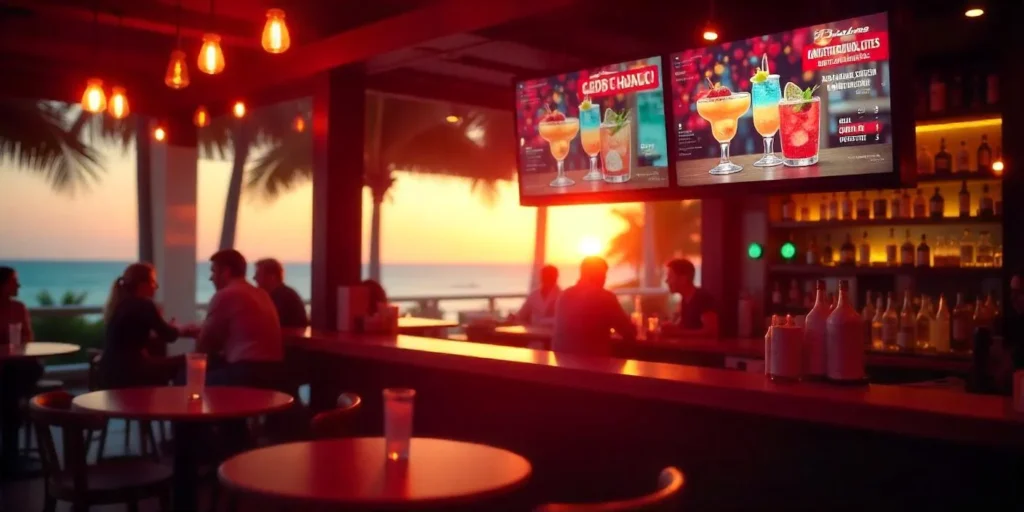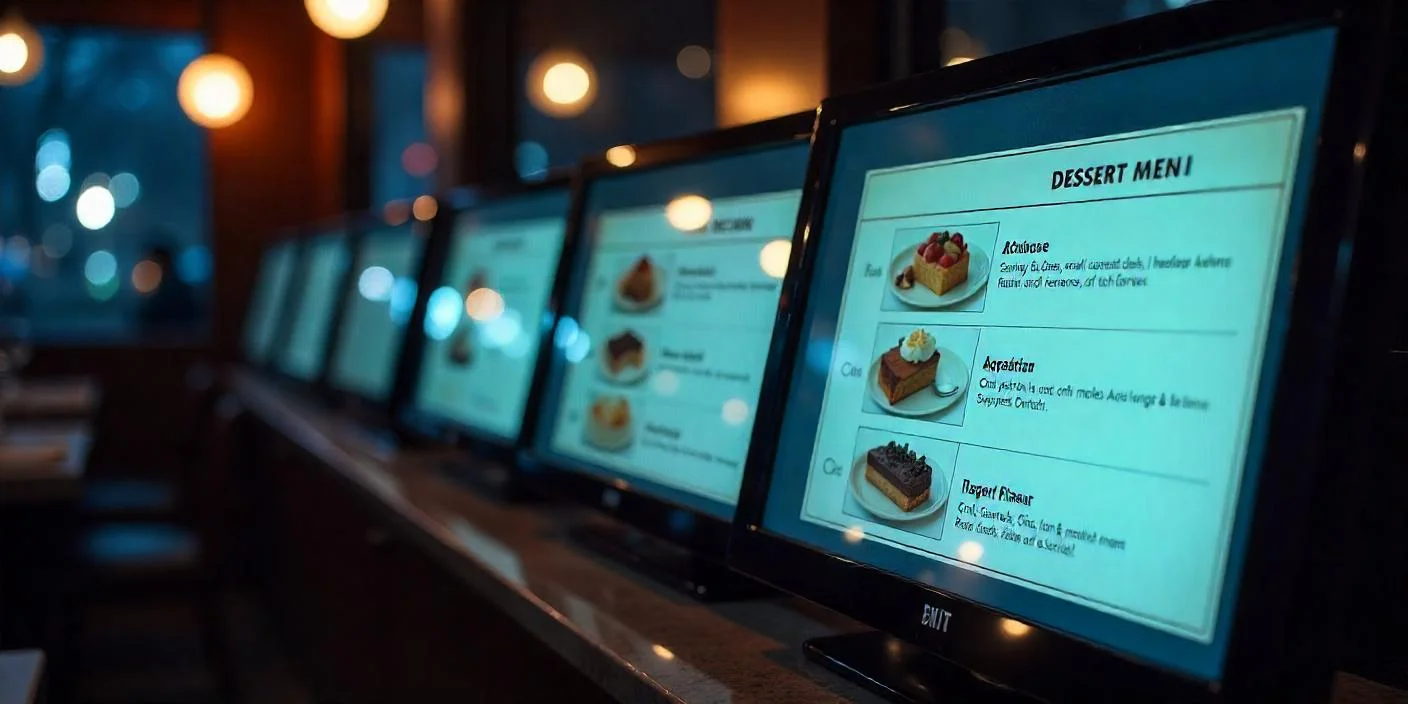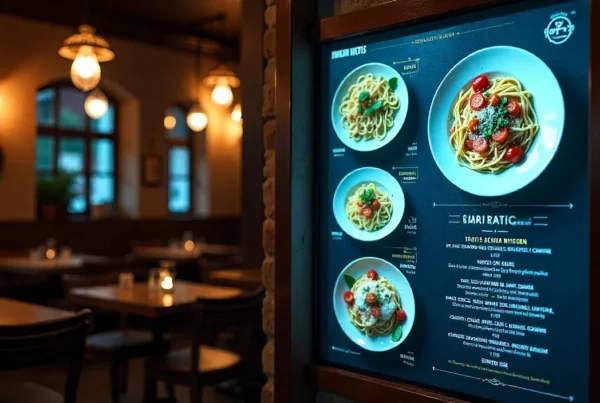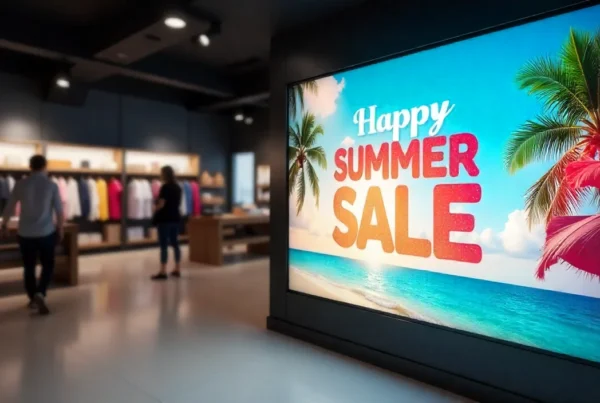Restaurants in the industry swiftly adopt digital tools as they seek improved operational performance alongside better services for their customers. Digital signage solutions also known as a restaurant menu monitors have emerged as the modern replacement for static menus.
Digital menu boards are also known as electronic menu boards, which provide restaurants with unmatched flexibility, operational convenience, and visual appeal. The modern presentation of menus is revolutionized by digital monitors, which can be found both in food truck menu boards and cozy bistro cafe menu boards.
This guide will demonstrate how restaurant menu display monitor designs enhance operations and how digital signage software benefits different food service businesses to drive sales and maintain brand identity while creating real-time customer engagement.

Why Restaurants Are Switching to Digital Menu Monitors
Digital signage represents a permanent business improvement solution that businesses have recognized as an effective strategy. Restaurant menu monitors are rapidly gaining popularity because they provide several benefits to the food service industry.
Dynamic & Flexible Menu Updates
The necessity to reprint menus for seasonal dishes or price changes no longer exists. Restaurants can perform instant menu updates through their restaurant menu monitor software. The cloud-based dashboard lets restaurant staff conduct menu revisions, including breakfast updates, lunch promotions, and weekend specials through easy adjustments.
Enhanced Visual Appeal
TV monitors present a superior option to printed menus because they display dishes through vivid videos and rich visual content. High-definition visuals serve two psychological purposes: they stimulate appetite and drive customers toward impulsive buying decisions.
Improved Customer Experience
Digital signage in restaurants delivers an integrated dining experience that delivers better information to customers. Restaurant customers appreciate the detailed information displayed, including dietary facts together with allergy alerts and language capability, because these additions make them confident about their dining decisions.
Cost-Effective Over Time
The high initial cost required for a restaurant’s digital signage platform results in prolonged savings when compared to traditional printed menu production costs. Your establishment will eliminate expenses for reprints while avoiding problems with outdated promotional materials. The operating expenses stay low because energy-efficient monitors reduce power consumption.
Boost in Sales & Upselling
The implementation of animated promotions alongside attention-grabbing callouts for time-limited offers and combos directly affects the average value of customer orders. Restaurant owners note higher upselling figures because they strategically position digital callouts on their premises.
Types of Restaurant Menu Monitors
The selection process for display equipment depends on how each business space looks and operates since each venue maintains its own distinct identity. The industry uses multiple standard digital menu board solutions that include the following:

Indoor Digital Menu Boards
Fast-food chains, together with coffee shops and sit-down restaurants, choose these solutions as their primary display option. The indoor restaurant menu display monitor designs come in different sizes with modern interior-friendly features and support both portrait and landscape orientations for flexible installation.
Outdoor Digital Menu Boards
Outdoor drive-thru menu boards are constructed with weatherproof enclosures together with high-bright screens that enable visibility under sunlight conditions. Outdoor service windows and lanes need these display monitors as essential equipment for quick-service restaurants.
Interactive Touchscreen Menu Boards
The self-service kiosk environment, together with food hall areas, benefits from interactive menu boards
that provide customers with in-screen menu browsing and customization features and payment capabilities. The technology improves customer interaction and decreases customer wait periods.
Menu Boards for Food Trucks & Cafes
The requirements of smaller operations include screens that are energy-efficient, compact in size, and lightweight in construction. The design needs for portable, durable food truck menu displays differ from those required by cafe menu boards that need to showcase artistic visuals and creative fonts to match their interior decorations.
Drive-Thru & QSR Menu Monitors
The menu monitors operate through digital menu board software that connects POS systems to show real-time menu updates. Their displays tend to be bigger because busy service times require better visibility.
Choosing the Right Restaurant Menu Monitor Software
Intuitive software powers the operation of every successful restaurant menu monitor. The following criteria should be your main guide when choosing a solution.
Cloud-Based Control
Restaurant owners gain full control over multiple monitors by using digital signage software accessible through any device. The ability to access the system remotely ensures complete adaptability for updating specials and content scheduling.
Design Simplicity with Drag-and-Drop Tools
Each restaurant operates without an in-house graphic designer. Visual design convenience and template libraries are essential features that come together through drag-and-drop interfaces. The tools provided enable users with no technical experience to create visually striking menus of professional quality.
Seamless POS Integration
Restaurant menus monitor software that integrates with Toast, Square, and Clover POS platforms stands as the best option. The built-in connection between this tool and POS systems drives automatic restocking and pricing updates that establish both accuracy and trust among customers.
Support for Multimedia Content
The modern menu exists beyond static design elements as it now includes animated interfaces that engage the audience coherently. The best platforms allow businesses to use GIFs, videos, slideshows and high-res images to present their brand story and generate customer involvement.
Performance Insights
The software contains analytical tools that monitor the popularity of dishes based on viewer interactions. Price optimization and menu structure become more manageable through the analysis of screen-based consumer behavior, which lets you extract maximum value from each display element.
Top Restaurant Menu Monitor Software Platforms
The selection of suitable digital menu board software starts with these well-known options:
• Yodeck – Cost-effective for startups and food trucks.
• ScreenCloud – Great for scalability across locations.
• NoviSign – Offers both user-friendly operation and solid template design capabilities.
• Nento Digital Signage – Ideal for enterprise-level needs.
• BrightSign – Known for high performance and reliability in drive-thru setups.

What to Look for in a TV Monitor for Restaurant Menus
The display screen functions as your menu; therefore, you need to select a quality one. The selection of a TV monitor for restaurant menus requires attention to these key factors
Size & Resolution
Indoor settings should use TV screens ranging from 32″ to 55″ to fit various wall arrangements. Select 4K UHD resolution because it enables a clear and pleasing presentation of menu items.
Brightness & Anti-Glare
The combination of 500 nits brightness and anti-glare coatings on outdoor menus and windows will keep their content visible regardless of strong outdoor lighting conditions.
Durability
The lifetime expectancy of consumer-grade TVs is reduced by extended usage. Select commercial-grade monitors from brands like Samsung QMR Series and LG Ultra HD signage displays because they serve 24/7 operations and handle heat effectively.
Orientation Options
The layout determines whether landscape mode suits promotional videos better than portrait mode for menu elements that need vertical scrolling.
Keep Your Menus in Motion — And Your Brand Too
The transition to restaurant menu monitors serves multiple strategic purposes, including improving customer experience, reducing operational efficiency, and generating revenue. Digital signage solutions represent the future of menu presentation because they have replaced traditional paper menus in fast-food joints as well as upscale bistros.
The combination of the appropriate restaurant menu monitor software and performance-driven displays allows you to enhance your brand effectiveness and visibility while increasing profitability.
All restaurant operators, including mobile food services along with fast food outlets, must welcome the digital dining transformation. The right menu monitor setup for today will allow your screens to handle the selling process effectively.
FAQs About Restaurant Menu Monitors
How much do restaurant menu monitors cost?
A basic menu display system, including screens, costs between $500 and up to $3,000 depending on screen specifications and material quality. Software subscriptions for restaurant menu displays cost between $20 and $100 monthly.
Can I use a regular TV?
Commercial displays surpass regular displays because they last longer, show images better, and are meant for continuous operation.
Is the internet required?
The system functions offline, but cloud-based updates, together with remote management, need a connection to the internet.
Are they energy-efficient?
The modern LED-backlit display technology operates with exceptional efficiency. The devices come equipped with motion sensors that automatically decrease brightness levels when systems are idle.
Can digital menu boards integrate with POS?
Absolutely. The majority of digital signage software platforms enable users to integrate their systems with major POS solutions for automated menu content updates.
What content works best on a digital menu?
A rich customer experience can be developed through the combination of high-resolution photos, short videos, promotional slides, allergy warnings, and real-time availability notices.





